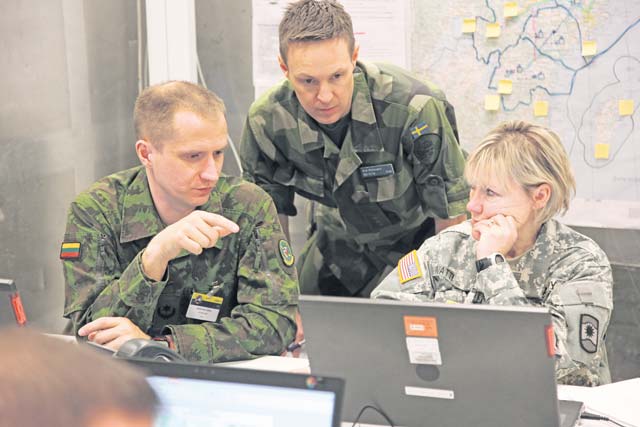
ENKOPING, Sweden — A snap of cold air engulfed Sweden as more than 2,500 military service members and civilians from more than 50 nations participated in Viking 14, a command post exercise hosted every three years since 1999 by the Swedish armed forces and Folke Bernadotte Academy, March 31 to April 10.
Approximately 20 7th Civil Support Command Soldiers with the 361st Civil Affairs Brigade also participated in the event.
The CPX was spread out across eight exercise sites in five different countries, including the Republic of Georgia, Bulgaria, Ireland, Serbia and four in Sweden.
The training scenario depicted the fake country of “Bogaland” six months after the country emerged from a civil war.
“Viking 14 is a multinational crisis response exercise,” said Army Capt. Joshua Koncar, logistics officer, 361st CA Bde., 7th CSC.
According to the exercise pocket guide, “the aim of exercise Viking 14 is to prepare, train and educate participants — civilian, military and police — to cooperate effectively and meet the challenges of current and future multidimensional crisis response and peace operations.”
In past and during some present conflicts and disaster responses, including those currently going on in Afghanistan, Haiti and several countries in Western Africa, a joint multinational military-civilian-led command, sometimes headed by NATO, is stood up to implement a United Nations peacekeeping and stability operation based on Chapters VI, VII and/or VIII from the U.N. charter.
The staff sections during Viking 14 were designed to simulate the current roles of the U.N. and NATO’s International Security and Assistance Force in Afghanistan and also drew upon current and past crisis response experiences in the Middle East and Africa, said Swedish army Maj. Richard Kjaergaard, Viking 14 exercise public affairs officer.
The joint multinational military-civilian exercise participants trained during the course of the exercise in ways to weave their collective decision-making process and objectives using a comprehensive approach to increase cooperation and interoperability between partner nations, he added.
“The Swedish armed forces did a really good job developing a real life (like) scenario with regards to U.N. mandated crisis response,” Koncar said.
The training exercise with more than 90 different non-governmental organizations and international organizations focused on the parallel missions that occur during operations in a post crisis/conflict area to help unstable areas become stable and make steady progress going forward.
“I think, first of all, working with the international environment is a great opportunity,” said Lithuanian army Maj. Gediminas Latvys, currently a student at the Baltic Defense College and an officer in the Lithuanian army. Latvys graduated from the U.S. Army Civil Affairs course in 2004 and has deployed to Kosovo and Afghanistan.
The CPX’s NATO Joint Forces Command operated side by side with two equivalent and parallel civilian commands, the U.N. Headquarters and the European Union’s Civil Administration Mission (EUCAM).
The 7th CSC Soldiers from the 361st CA Bde. worked together with partner nations’ civil military cooperation (CIMIC) Soldiers and civilians to exercise their readiness for any future manmade crisis or natural disaster or post conflict as part of the exercise’s Land Component Command under the “Bogaland” Forces, or BFOR HQ, which reported to the fictional NATO Joint Forces Command.
“Our goals include assisting our NATO partners in developing their civil-military capabilities as well as developing our own,” said Army Lt. Col. Keith Gawrys, functional specialist with the 361st CA Bde., 7th CSC, who works for a civilian defense contractor in his day job. “We are also here to bridge the gap between NATO and U.S. civil-military doctrine. The U.S. speaks ‘Civil Affairs,’ and NATO speaks ‘CIMIC,’ or civil military cooperation.”
The joint multinational military-civilian exercise participants trained in how to weave their collective decision-making process and objectives using a comprehensive approach to increase cooperation and interoperability between partner nations.
“It’s very relevant to use in these types of exercises the comprehensive approach by having military and civilian working side by side,” Latvys said. “Our daily interactions and cooperation with the civilians help to better understand the contemporary operational environment and plan appropriate civil-military operations. We conduct the meetings and planning process together because this is what we do when deployed to a theater of operation whether it is in peace time or war time.”
Viking 14 gave the military participants the chance to work closely with NATO, UN, EU, NGOs, GOs and other international organizations at the same time, “because when they deploy, that is the reality they will see on the ground,” said Angelica Bille-Bergman, a Swedish armed forces CIMIC exercise planner.
“All organizations have cultures and a way to handle various situations,” Bille-Bergman said. “This is an excellent opportunity to learn from each other, get to know each other’s cultures and work in this type of environment. You’re able to work closely with each other, which enhances cooperation and the speed of the mission.”
Koncar said the main takeaway was a greater level of understanding of how to interact with non-government agencies, as well as other nations during a crisis response.
“What is most important is the understanding between the civilians and the military, so that they make their mistakes here,” said Swedish armed forces Maj. Gen. Bengt Andersson, Viking 14 military exercise director. “So when they go to the field, there are (none).”







